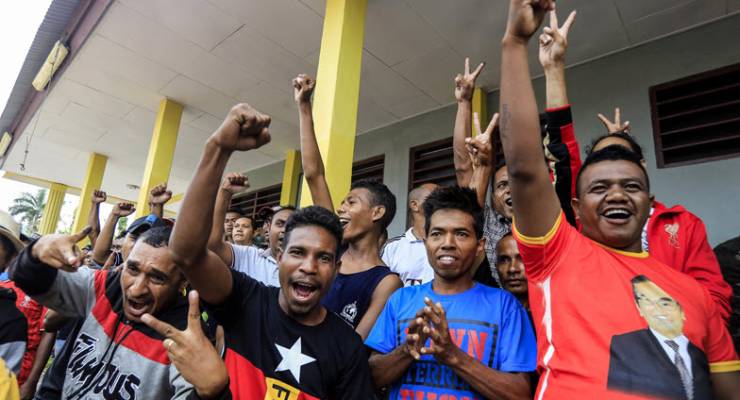
East Timor’s presidential election looks to have produced a strong victory for Fretilin’s serial candidate, Francisco Guterres, known as Lu-Olo. While results remains unofficial, based on a largely complete tally, Lu-Olo was looking to have just under 60% of the total vote for the mostly ceremonial role of president.
This means that Lu-Olo will comfortably surpass the 50% plus one requirement for being elected as president without having to go to a run-off round. He will be the first presidential candidate to have won an absolute majority in the first presidential round since Xanana Gusmao was overwhelmingly elected as president in 2002.
Fretilin has already said that, if this vote is extrapolated into the parliamentary elections due mid-year, it intends to form a “government of national unity”. In 2001, Fretilin received around two-thirds of the vote, but its support massively slumped soon after, with riots in the early 2000s culminating in the civil breakdown and external intervention of 2006.
After eight years in opposition, Fretilin currently governs in coalition with Xanana Gusmao’s National Congress for Timorese Reconstruction (CNRT). Gusmao had openly thrown his political support behind Lu-Olo for the presidency.
If the presidential election results remain on track, this will mark an improvement in both the vote of Fretilin and CNRT. In 2012, Lu-Olo received just under 29% of the vote, while Taur Matan Ruak, supported by CNRT, received just under 26% of the vote in the first round.
Ruak’s vote jumped to almost 62% in 2012’s second round, however, as minor parties consolidated their vote around his candidature. It appears that Gusmao’s call for support for Lu-Olo in the 2017 election persuaded enough voters beyond Fretilin and CNRT’s immediate support base to provide Lu-Olo with a comfortable margin of victory.
After standing as president in 2002 and giving his blessing to the successful presidential candidature of Jose Ramos-Horta in 2007 and Taur Matan Ruak in 2012, it appears that Gusmao’s personal authority as “king or kingmaker” remains intact.
Lu-Olo’s main opponent, the Democratic Party (PD)’s Antonio da Conceicao, looks to have around 30% of the vote, with six other candidates sharing the remainder of the vote between them. Da Conceicao’s electoral performance was relatively strong, given the PD’s past presidential vote was around 17% (11% in 2007).
Da Conceicao’s vote was bolstered by support from outgoing President Taur Matan Ruak’s recently established People’s Liberation Party (PLP).
It is expected that the parliamentary elections, likely to be held in early July, will continue to approximately reflect the outcome of the presidential elections, as they did in 2007 and 2012. If this is the case, Fretilin and CNRT are likely to reform their governing coalition, and may invite individuals from other parties to take minor ministerial positons. Such a scenario would provide the continued stability and predictability of the current coalition government.
The real question, in such a scenario, will be whether the PD and PLP maintain their own alliance formed for the presidential election, thus providing East Timor a viable parliamentary opposition. The PLP in particular has run a very strong campaign against East Timor’s perceived growing corruption and can be expected to do so into the parliamentary elections.
From an Australian perspective, the key issue revolves around East Timor’s bid to have a permanent maritime boundary drawn between the two countries consistent with the United Nations Convention on the Law of the Sea. Lu-Olo has been muted in his comments on the issue.
This may reflect the fact that East Timor’s presidency is a largely ceremonial position and is not supposed to be involved in matters of day to day policy. However, given other presidents’ willingness to speak beyond the constitutional bounds of the position, Lu-Olo’s muteness could be construed as unhelpful to a process that is currently under negotiation between Australia and East Timor.
East Timor has, for the past eight or so years, argued strongly in favour of an absolute median line boundary which includes the lucrative Greater Sunrise liquid natural gas field within its territorial waters. However, East Timor’s oil fields, which have so far funded the state’s sovereign wealth Petroleum Fund and provided capital for infrastructure development, are beginning to reduce production ahead of depletion.
Due to the international reluctance to develop a liquefied national gas processing facility on East Timor’s south coast and the financial clock beginning to tick for its economy, the country may alter its existing Timor Sea claims. Despite its strong position under international law, economic reality may oblige East Timor’s next government to consider the options that will be available to help ensure the country remains economically viable.
*Damien Kingsbury is a professor of international politics at Deakin University, and co-ordinator of the 2017 Australia East Timor Election Observer Mission.








An absolute median line boundary does not include the Greater Sunrise liquid natural gas field within East Timor’s territorial waters. To get the Greater Sunrise field, East Timor has to go over onto the Indonesian side of the median line boundary between East Timor and Indonesia.
Because the permanent boundary between Australia and Indonesia was settled on the ‘continental shelf’ principle, part of Australia’s settled territorial waters is closer to East Timor than to Australia. But all of that is closer to Indonesia than to East Timor, too.
If, as between Australia and East Timor, it is reallocated…then Indonesia, which is not a party to that claim, will make its own ‘absolute median line’ claim. East Timor has no defence to that claim.